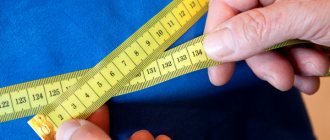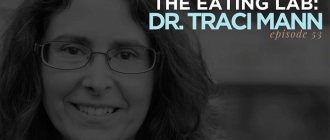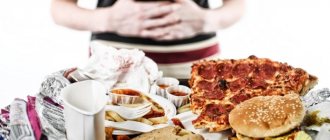General rules
The developer of the diet, BBC television journalist Michael Mosley, by virtue of his professional activities, participated in an experiment that was conducted at the Baltimore Institute on Aging and the Longevity Institute of Southern California. The experiment was related to the study of the effect of fasting on the duration and quality of human life. A 24-hour fast or a low-calorie diet every other day was suggested. It turned out that such a diet stabilizes blood sugar levels, promotes the effective production of growth hormone and reduces the risk of cardiovascular diseases and cancer. Dietary restrictions improve mood and protect the brain from senile dementia and Alzheimer's disease .
He was convinced to try unloading by the current health situation - high blood sugar and excess weight. Michael decided to test his own version of the diet: five days a week he ate as usual, and two days (for him it was Monday and Thursday) he fasted with reduced calories. He tried more frequent unloading, but came to the conclusion that they were inconvenient for an active person and difficult to endure emotionally.
After being on this diet for 1.5 months, he lost 6 kg, and the experience gained helped him create a new direction and write the book “Fast Diet 5:2.” This is how the diet of the same name appeared. According to the author, this nutritional system, on the one hand, is gentle, since it assumes a balanced and habitual diet for each person for five days a week, and two days as fasting days with a reduced calorie content.
On the other hand, it is effective because it is not associated with long-term low-calorie nutrition, to which the body gradually gets used to and switches to saving mode, slowing down metabolism . Short-term low-calorie fasting is useful for “shake-up” metabolism. However, on ordinary days a person should eat right, control his appetite, portions and not overeat. By limiting calories, the processes of cleansing and healing the body are launched. The diet is not harmful to the body, so it can be used constantly.
Weight loss is only one of the advantages of the diet, and in 2.5 months you can really get rid of 5 kg. The big benefit is that you can improve your health and reduce the risk of a number of diseases. Partial abstinence from food for a short time has a positive effect on health, as a healing program is launched and the recovery gene is “turned on.” Periodic unloading reduces the level of IGF-1, which plays a role in the occurrence of cancer.
This is due to the fact that high protein content provokes an increase in IGF-1 levels. By limiting protein intake to intermittent fasting, IGF-1 can be kept at normal levels. Dr. Valter Longo (Longevity Institute at the University of Southern California) believes that to reduce IGF-1, you need to do four fasting days every few months and always in a row, skip meals and stay on a low-protein diet. However, such advice is unacceptable for many and you can stop at a two-day fasting. By exposing the body to alternating periods of eating and partial fasting, we change our metabolism for the better.
Michael Mosley's 5:2 Fast Diet is suitable for people who cannot stick to a diet for a long time, feel deprived and constantly break down. The main thing is to stick to fasting days regularly, and eat healthy on other days of the week, excluding overeating. Thus, in 2 months you can lose 4-6 kg. On fasting days, a completely balanced menu is offered, including protein, carbohydrates in the form of vegetables, fats (vegetable oil, nuts). Products should be healthy and have a low glycemic index . For example, protein products yogurt, egg, cottage cheese with berries are ideal for breakfast, for dinner - fish with vegetables, nuts, chia seeds (or vegetable oil). Cook vegetables and meat/fish in a healthy way - in a slow cooker or steamer.
Rules for two fasting days:
- Calorie restriction: women up to 500 kcal, men up to 600 kcal.
- Drink enough water, herbal infusions and herbal teas.
- Eating twice a day, 12 hours apart, without snacks. If you still need to snack, do it in moderation, not forgetting about the glycemic index.
- Dividing the daily calorie intake into two meals (for example, 200 and 300 kcal, 150 and 350 kcal).
- Fasting days can be done consecutively or alternated with regular meals.
- Create a diet at your own discretion, without going beyond the permissible calorie limits. Choose dishes that do not contain flour, dough, or sugar. The diet should not include high-calorie foods and dishes.
- Do not drink alcoholic beverages.
For many, it seems convenient that on fasting days you can eat a varied diet and tailor your diet to your preferences. If you don’t like cottage cheese, you can make a carbohydrate breakfast: any porridge with mushrooms (50 g of cereal and 100 g of champignons). For dinner you can cook vegetable soup, baked fish and eat grapefruit. You can create many menu options, the main thing is that the daily energy balance does not exceed the permissible limit. To do this, you need to study the calorie content of foods and ready-made meals.
How to overcome the hunger that arises these days?
We eat when we're thirsty, we're bored when food is nearby or it's time for lunch. Often the desire to eat is a reaction to external stimuli. Get rid of junk food so it doesn't tease you and prepare food for your fasting day in advance. The most difficult thing is the first weeks, when the body adapts to new eating habits and a new diet. Of course, you will have to take your will into your fist, restrain yourself and be distracted.
Go for a walk, take a shower, drink warm herbal tea or water. You must be aware that this is a break between meals and in the evening you will be able to eat. At the same time, the brain is reprogrammed and hunger will subside. If at first you can’t take a 12-hour break, take as long as possible. Try the routine from 2 pm to 2 pm on the day following it. When eating, try not to rush, chew slowly and eat small pieces.
Having achieved, perhaps in a few months, the desired result, you need to switch to a maintenance mode - arrange one fasting day to maintain weight. One day a week, when done long-term, has less of a healing effect on the body, but it is easier to maintain, and it will easily fit into your life if you are interested in maintaining body weight rather than losing it.
How to eat healthy on other days
For two days a week, you should limit your intake to 500–600 calories per day. However, for the remaining five days, you can stick to your normal diet without counting calories.
It's best to fill your plate with healthy ingredients. Such as fruits, vegetables, proteins, whole grains, nuts, seeds and healthy fats. While there are no specific guidelines for what foods should be consumed during a week on the 5:2 diet. Conversely, processed ingredients such as sweetened drinks, frozen foods, and junk foods should be limited.
Here are some delicious 5:2 diet recipes to get you started:
- Greek Chicken Souvlaki Recipe
- Recipe for Braised Collard Greens with Cajun Spices
- Stuffed Peppers with Beef and Quinoa Recipe
- Recipe for vegetable sauté with zucchini
- Spaghetti squash with broccoli recipe
Authorized Products
- Whole grains, granola, brown rice, oats and quinoa. If you are not too lazy to count calories, you can mix different cereals (bulgur, couscous, quinoa) - they are all rich in vegetable protein and fiber.
- Healthy protein options: steamed fish, skinless chicken breast, shrimp, salmon, tuna, tofu, hummus, lentils and other legumes.
- Eggs, which have high nutritional value with low calorie content (90 one). A protein breakfast creates a feeling of fullness for a long time. For breakfast, you can boil two eggs and add 50 g of smoked salmon to them or steam asparagus with an omelet.
- Dairy products with lower fat content (1% or 2% kefir, yogurt, cottage cheese, milk). It is better not to eat cheese on a fasting day due to its high calorie content.
- Nuts and seeds (sunflower and pumpkin) contain fiber and therefore can dull hunger on a fasting day. These products are perfectly satiating, have a low GI, however, they are very high in calories, so their quantity will have to be strictly taken into account. Almonds, pistachios, cashews make the dish satisfying and enliven the taste of any salad.
- Vegetable oil in the amount of a teaspoon can be used in cooking or salad dressing. Dressing vegetables with vegetable oil is necessary for the absorption of fat-soluble vitamins .
- Lemon and orange juice for dressing salads to fully absorb iron from leafy vegetables.
- Vegetables and legumes (peas, beans and lentils). Give preference to green vegetables and herbs (spinach, mustard greens, chard, dill, parsley, lettuce). This could be boiled broccoli, green beans with garlic and vegetable oil, raw carrots with hummus. Vegetable soups and miso soup are suitable for those who like first courses.
- As for fruits, give preference to citrus fruits, which are high in nobiletin , which protects against obesity . Grapefruits contain 39 kcal per half fruit. An apple is convenient to eat, but quite high in calories (it immediately eats 50 kcal from your diet).
- Drinks - water, herbal tea, vegetable broth, low-calorie instant hot chocolate with water (40 kcal), hot water with mint, cloves, ginger or lemon, green tea and coffee without milk and sugar. If coffee invigorates and gives you tone, don’t give it up.
Table of permitted products
| Proteins, g | Fats, g | Carbohydrates, g | Calories, kcal | |
Vegetables and greens | ||||
| eggplant | 1,2 | 0,1 | 4,5 | 24 |
| beans | 6,0 | 0,1 | 8,5 | 57 |
| zucchini | 0,6 | 0,3 | 4,6 | 24 |
| cabbage | 1,8 | 0,1 | 4,7 | 27 |
| broccoli | 3,0 | 0,4 | 5,2 | 28 |
| Brussels sprouts | 4,8 | 0,0 | 8,0 | 43 |
| cauliflower | 2,5 | 0,3 | 5,4 | 30 |
| green onion | 1,3 | 0,0 | 4,6 | 19 |
| bulb onions | 1,4 | 0,0 | 10,4 | 41 |
| carrot | 1,3 | 0,1 | 6,9 | 32 |
| cucumbers | 0,8 | 0,1 | 2,8 | 15 |
| squash | 0,6 | 0,1 | 4,3 | 19 |
| salad pepper | 1,3 | 0,0 | 5,3 | 27 |
| parsley | 3,7 | 0,4 | 7,6 | 47 |
| salad | 1,2 | 0,3 | 1,3 | 12 |
| beet | 1,5 | 0,1 | 8,8 | 40 |
| celery | 0,9 | 0,1 | 2,1 | 12 |
| soybeans | 34,9 | 17,3 | 17,3 | 381 |
| asparagus | 1,9 | 0,1 | 3,1 | 20 |
| tomatoes | 0,6 | 0,2 | 4,2 | 20 |
| pumpkin | 1,3 | 0,3 | 7,7 | 28 |
| dill | 2,5 | 0,5 | 6,3 | 38 |
| beans | 7,8 | 0,5 | 21,5 | 123 |
| garlic | 6,5 | 0,5 | 29,9 | 143 |
| lentils | 24,0 | 1,5 | 42,7 | 284 |
Fruits | ||||
| avocado | 2,0 | 20,0 | 7,4 | 208 |
| oranges | 0,9 | 0,2 | 8,1 | 36 |
| pomegranate | 0,9 | 0,0 | 13,9 | 52 |
| grapefruit | 0,7 | 0,2 | 6,5 | 29 |
| pears | 0,4 | 0,3 | 10,9 | 42 |
| lemons | 0,9 | 0,1 | 3,0 | 16 |
| mango | 0,5 | 0,3 | 11,5 | 67 |
| tangerines | 0,8 | 0,2 | 7,5 | 33 |
| nectarine | 0,9 | 0,2 | 11,8 | 48 |
| peaches | 0,9 | 0,1 | 11,3 | 46 |
| apples | 0,4 | 0,4 | 9,8 | 47 |
Berries | ||||
| gooseberry | 0,7 | 0,2 | 12,0 | 43 |
| Red currants | 0,6 | 0,2 | 7,7 | 43 |
| black currant | 1,0 | 0,4 | 7,3 | 44 |
Nuts and dried fruits | ||||
| nuts | 15,0 | 40,0 | 20,0 | 500 |
| almond | 18,6 | 57,7 | 16,2 | 645 |
| flax seeds | 18,3 | 42,2 | 28,9 | 534 |
| fenugreek seeds | 23,0 | 6,4 | 58,3 | 323 |
| sunflower seeds | 20,7 | 52,9 | 3,4 | 578 |
Cereals and porridges | ||||
| buckwheat (kernel) | 12,6 | 3,3 | 62,1 | 313 |
| oat groats | 12,3 | 6,1 | 59,5 | 342 |
| cereals | 11,9 | 7,2 | 69,3 | 366 |
| wheat bran | 15,1 | 3,8 | 53,6 | 296 |
| brown rice | 6,3 | 4,4 | 65,1 | 331 |
Raw materials and seasonings | ||||
| basil | 2,5 | 0,6 | 4,3 | 27 |
Dairy | ||||
| kefir 0% | 3,0 | 0,1 | 3,8 | 30 |
| kefir 1% | 2,8 | 1,0 | 4,0 | 40 |
Cheeses and cottage cheese | ||||
| cottage cheese 0.6% (low fat) | 18,0 | 0,6 | 1,8 | 88 |
| curd tofu | 8,1 | 4,2 | 0,6 | 73 |
Meat products | ||||
| beef | 18,9 | 19,4 | 0,0 | 187 |
Bird | ||||
| chicken fillet | 23,1 | 1,2 | 0,0 | 110 |
| turkey | 19,2 | 0,7 | 0,0 | 84 |
Eggs | ||||
| eggs | 12,7 | 10,9 | 0,7 | 157 |
Fish and seafood | ||||
| fish | 18,5 | 4,9 | 0,0 | 136 |
| squid | 21,2 | 2,8 | 2,0 | 122 |
| shrimps | 22,0 | 1,0 | 0,0 | 97 |
| salmon | 19,8 | 6,3 | 0,0 | 142 |
| seaweed | 0,8 | 5,1 | 0,0 | 49 |
| mackerel | 18,0 | 13,2 | 0,0 | 191 |
| cod | 17,7 | 0,7 | — | 78 |
Oils and fats | ||||
| grape seed oil | 0,0 | 99,9 | 0,0 | 899 |
| linseed oil | 0,0 | 99,8 | 0,0 | 898 |
| olive oil | 0,0 | 99,8 | 0,0 | 898 |
Non-alcoholic drinks | ||||
| mineral water | 0,0 | 0,0 | 0,0 | — |
| instant chicory | 0,1 | 0,0 | 2,8 | 11 |
| green tea | 0,0 | 0,0 | 0,0 | — |
| * data is per 100 g of product | ||||
Fully or partially limited products
- Fatty and high-calorie foods.
- Foods that have a high glycemic index .
- Fruit juices due to their sugar content, store-bought smoothies and cocktails.
- Sugar, sweets, baked goods.
- Butter and other animal fats.
Table of prohibited products
| Proteins, g | Fats, g | Carbohydrates, g | Calories, kcal | |
Fruits | ||||
| bananas | 1,5 | 0,2 | 21,8 | 95 |
Nuts and dried fruits | ||||
| raisin | 2,9 | 0,6 | 66,0 | 264 |
Cereals and porridges | ||||
| semolina | 10,3 | 1,0 | 73,3 | 328 |
| white rice | 6,7 | 0,7 | 78,9 | 344 |
Flour and pasta | ||||
| pasta | 10,4 | 1,1 | 69,7 | 337 |
Bakery products | ||||
| bagels | 16,0 | 1,0 | 70,0 | 336 |
| bagels | 16,0 | 1,0 | 70,0 | 336 |
| crackers | 11,2 | 1,4 | 72,2 | 331 |
Confectionery | ||||
| jam | 0,3 | 0,2 | 63,0 | 263 |
| jam | 0,3 | 0,1 | 56,0 | 238 |
| candies | 4,3 | 19,8 | 67,5 | 453 |
| pastry cream | 0,2 | 26,0 | 16,5 | 300 |
Ice cream | ||||
| ice cream | 3,7 | 6,9 | 22,1 | 189 |
Cakes | ||||
| cake | 4,4 | 23,4 | 45,2 | 407 |
Chocolate | ||||
| chocolate | 5,4 | 35,3 | 56,5 | 544 |
Raw materials and seasonings | ||||
| ketchup | 1,8 | 1,0 | 22,2 | 93 |
| mayonnaise | 2,4 | 67,0 | 3,9 | 627 |
Dairy | ||||
| cream | 2,8 | 20,0 | 3,7 | 205 |
| sour cream 30% | 2,4 | 30,0 | 3,1 | 294 |
| sour cream 40% (fat) | 2,4 | 40,0 | 2,6 | 381 |
Cheeses and cottage cheese | ||||
| cheese | 24,1 | 29,5 | 0,3 | 363 |
| cottage cheese 18% (fat) | 14,0 | 18,0 | 2,8 | 232 |
Meat products | ||||
| pork | 16,0 | 21,6 | 0,0 | 259 |
| pork liver | 18,8 | 3,6 | 0,0 | 108 |
| pork kidneys | 13,0 | 3,1 | 0,0 | 80 |
| pork fat | 1,4 | 92,8 | 0,0 | 841 |
| salo | 2,4 | 89,0 | 0,0 | 797 |
| beef liver | 17,4 | 3,1 | 0,0 | 98 |
| beef kidneys | 12,5 | 1,8 | 0,0 | 66 |
| beef brains | 9,5 | 9,5 | 0,0 | 124 |
| mutton | 15,6 | 16,3 | 0,0 | 209 |
Sausages | ||||
| smoked sausage | 16,2 | 44,6 | 0,0 | 466 |
| smoked sausage | 9,9 | 63,2 | 0,3 | 608 |
| sausages | 10,1 | 31,6 | 1,9 | 332 |
| sausages | 12,3 | 25,3 | 0,0 | 277 |
Bird | ||||
| smoked chicken | 27,5 | 8,2 | 0,0 | 184 |
| duck | 16,5 | 61,2 | 0,0 | 346 |
| smoked duck | 19,0 | 28,4 | 0,0 | 337 |
| goose | 16,1 | 33,3 | 0,0 | 364 |
Fish and seafood | ||||
| smoked fish | 26,8 | 9,9 | 0,0 | 196 |
| Red caviar | 32,0 | 15,0 | 0,0 | 263 |
| canned fish | 17,5 | 2,0 | 0,0 | 88 |
| semi-finished fish products | 12,5 | 6,7 | 14,7 | 209 |
| boiled oysters | 14,0 | 3,0 | — | 95 |
| fresh oysters | 14,0 | 6,0 | 0,3 | 95 |
Oils and fats | ||||
| butter | 0,5 | 82,5 | 0,8 | 748 |
| creamy margarine | 0,5 | 82,0 | 0,0 | 745 |
| coconut oil | 0,0 | 99,9 | 0,0 | 899 |
| palm oil | 0,0 | 99,9 | 0,0 | 899 |
| rendered beef fat | 0,0 | 99,7 | 0,0 | 897 |
| cooking fat | 0,0 | 99,7 | 0,0 | 897 |
| rendered pork fat | 0,0 | 99,6 | 0,0 | 896 |
Non-alcoholic drinks | ||||
| cola | 0,0 | 0,0 | 10,4 | 42 |
| lemonade | 0,0 | 0,0 | 6,4 | 26 |
| Pepsi | 0,0 | 0,0 | 8,7 | 38 |
| sprite | 0,1 | 0,0 | 7,0 | 29 |
| * data is per 100 g of product | ||||
Diet Menu 5:2 (Meal Mode)
As we found out, the menu can be compiled according to your preferences. Include your favorite dishes in your fasting day diet, make variations: add a different taste and change the texture of the dish. All this will help you stay motivated and make it easier to get through the fasting day.
Second, the combination of protein and low GI foods is a weapon against hunger. Therefore, pay attention to the glycemic index of foods. If you prefer carbohydrates for breakfast, then whole grain porridge or granola is a better choice than a bagel, corn muffin, corn flakes or buckwheat pancakes.
Protein foods are filling, so they should definitely be included in your calorie quota. At the same time, adhere to protein intake standards (45 g for women and 50 g for men). Below are menu options for 500 kcal per day.
| Breakfast |
|
| Dinner |
|
| Breakfast |
|
| Dinner |
|
If you need a snack, you can use carrots cut into plastic or sticks with hummus, or celery with hummus, a small handful of nuts. However, constant snacking, even low-calorie foods, is not recommended.
Useful tips for losing weight
Many women from different countries have already used this diet on themselves, noting the visible effect and its ease. Here are their helpful tips:
- It is advisable to write down everything you eat - it’s easier to control yourself. Phone apps are a great option, just search for “calorie calculator” on the Internet.
- You can eat any fruit except avocado and banana - they are very high in calories.
- If you feel hungry, you should first drink a glass of water, only after half an hour can you eat.
- If you snack on a few nuts, you won’t feel like eating for a long time.
- To improve the effect, it is good to engage in physical activity - fitness, yoga, Pilates, swimming pool.
- On ordinary days, you should not get carried away with sausages, chocolate or cakes; it is better to eat light salads, soups, and vegetables.
- Brussels sprouts, green peas, and spinach are very useful for weight loss.
- For snacks, you can take an apple or tangerine, eating them in small slices.
Advantages and disadvantages
| pros | Minuses |
|
|
What are the contraindications?
Diet 5 by 2: reviews from nutritionists limit people to losing weight in this way:
- having diseases of the gastrointestinal tract. Any changes in diet in this case may worsen the situation;
- with exacerbation of an infectious disease;
- in childhood or adolescence. During this period, a person needs to adhere to the principles of proper nutrition, because the body is actively developing and requires more energy.
Contraindications also apply to pregnant women and women breastfeeding.
Diet 5:2, reviews and results
The author claims that if you follow proper nutrition on the main days and use two fasting days, your weight will constantly decrease. However, it is not so easy to maintain such a low-calorie diet. Reviews of Michael Mosley's 5:2 diet testify to this. Many people cannot stand a 12-hour break in food intake and cut it short or have snacks.
Most report a constant feeling of hunger, which cannot be dulled by drinking water or vegetable broth. It is especially difficult at the beginning; over time, when the body adapts, a long break is tolerated somewhat easier. If you feel unwell and are experiencing unloading, be prudent and stop in time. Some people losing weight tolerated the unloading well for 1.5-2 months and showed good results. Weight loss during this period ranged from 4 to 6 kg.
The opinion of nutritionists towards this type of nutrition is negative. First of all, because the use of such restrictive diets causes metabolic disorders (it is inhibited, the hormone thyroxine , which is involved in metabolism, is not produced), the formation of gallstones and the return of weight even more than lost. In addition, a break of more than 5 hours leads to a sharp decrease in metabolism and accumulates “hunger potential”, when a person pounces on food and no longer cares whether this food is healthy or not.
- “... You need to approach unloading wisely and be in a good mood, then it will be much easier. It's actually not difficult. It is important to develop a meal plan for this day. I'm actually surprised how much more energy I have these days. It is very inspiring that the weight has begun to decrease, the volume has gone away from the abdomen and hips. The most important thing for me is that my blood pressure has returned to normal. It was easy for me that my husband supported me and we do unloading together on the same days and support each other. It’s easy to carry if you’re busy with work and don’t think about food all the time. We have been on the diet for 1.5 months already. Reduced weight by 3.5 and 4 kg. We are thinking of continuing this diet further, especially since there are positive changes in health. My husband’s blood sugar has returned to normal.”
- “... I was on a diet for one month, then I went on a long business trip and it became problematic to organize meals for myself in a hotel. Over the course of a month, positive changes occurred: I lost 3 kg, my taste preferences changed - now I choose healthy foods in my regular diet and began to think about calorie content and composition. I began to eat less meat and bread, and this happened unnoticed, naturally, without violence. Now, having returned home, I decided to continue the health program. I was very impressed by Michael Mosley’s book, which describes in detail, with references to research, all the positive aspects of recovery.”
- “... I didn’t like the long gap between meals: the body asked to chew something and coffee came in very handy during this period! The next day the appetite was brutal and in the following days too. Despite the fact that I ate correctly (protein, vegetables, practically no bread, sweets and pastries), I caught up with the 500 g that was lost on the day of fasting. The second unloading was the same - I easily lost 700 g, but regained it with a plus of 300 g. Moreover, the craving for sweet and fatty foods increased. So three weeks passed, and I managed to lose 1.5 kg. But I think due to basic proper nutrition and walking. Fasting days were a hindrance for me, because after them I was craving the wrong food (a sandwich with smoked sausage). I decided to always eat normally with cereals, vegetables and lean meat.”
Basic recommendations for fasting days
To make the diet productive for you, it is recommended to follow a few simple tricks:
- If you wish, add onions to the vegetable salad: chop the green ones, since onions contain up to 2 times more carbohydrates.
- Adding spinach, green peas or Brussels sprouts to the menu on “hungry” days will give you a noticeable feeling of fullness, since these foods are leaders in protein content.
- During low carb days, try to avoid bananas as they are very high in calories during this period.
- When you feel hungry: finely chop some fruit and eat it slowly.










